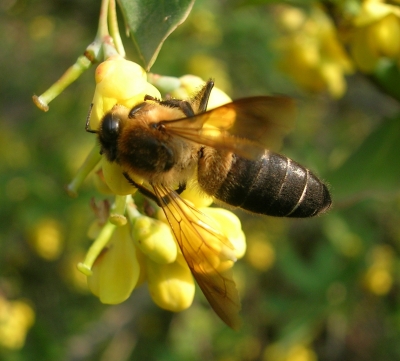
The Himalayan giant honeybee is the largest honeybee in the world, measuring up to 3 cm in length. Confined to the Himalayas, it is adapted to highland habitats, nesting at altitudes between 2500 and 3000 metres above sea level. It builds its huge nest on overhanging rock cliffs with each nest containing as much as 60 kg of honey.
The nests of giant honey bees are large single combs which can measure up to 1.5 m in width and 1 m in depth. This large single comb can contain upwards of 60,000 bees. Unlike dwarf honey bees or cavity nesting honey bee species, colonies of giant honey bees can be highly clustered in a specific location, with some trees in Asia (termed ‘bee trees’) containing multiple nests in a single tree, sometimes up to 50 nests.
Giant honey bee nests are usually built in exposed places far off the ground, sometimes 20–40 m high on thick branches of tree limbs, overhanging rocks or cliffs, or on buildings or other man-made structures. The key difference between dwarf honey bees and giant honey bees, apart from their nest size, is that giant honey bee nests hang underneath a structure such as a branch, whereas dwarf honey bee nests are wrapped around a structure such as a branch. Giant honey bee colonies can be quite aggressive, and because of this, around three quarters of the population of a giant honey bee colony are engaged in colony defense, forming a protective curtain around the nest that is three to four bees thick.
Giant honey bees are mainly tropical and in most places they migrate seasonally. Colonies are capable of migrating great distances, sometimes up to 200 km, as they follow the wet and dry seasons. Colonies will travel for many months, resting in trees along the way, building combs and honey reserves and then moving on to new locations as the forage decreases, before setting up new nests for the mass flowering of the monsoon season. Some evidence suggests that the bees are capable of returning to the same nest sites as previous years, even though all of the original bees in the process may be replaced. This mechanism of memory retention within the honey bee colony remains a mystery.
Credit : BeeAware
Picture Credit : Google




